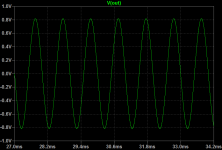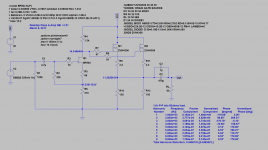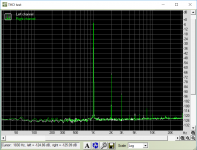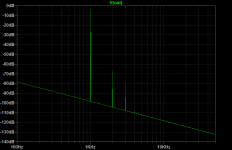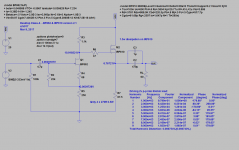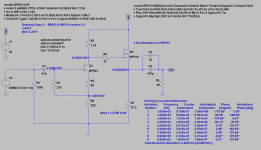XRK,
would you please provide your reference BOM for bf862 2SA1837 HA
Is this final http://www.diyaudio.com/forums/solid-state/301164-mosfet-source-follower-headamp-19.html#post4977872
Yes, that looks good - I do have a 1uF MKT 250v film cap as a bypass on the 390uF output cap (Panasonic OSCON 390uF 25v).
You will need 2W to 5W power resistors on R2 and R7, and make R6 a 100R trimmer pot. R4 could be 4.7R or two 10R's in parallel (which is what I had on hand). You could also make R8 a 5k trimmer pot set to 3.3k nominally and that lets you play with bias on the JFET gate. C4 needs to be high quality NP0/C0G cap. That should do it.
Note that a CFP amp has no PSRR to speak of so very careful attention needs to be paid to the best low ripple PSU you can find. I used 24v SMPS from a LED driver and a Juma Easy Peasy cap multiplier (4v drop) and then a massive low ESR cap bank.
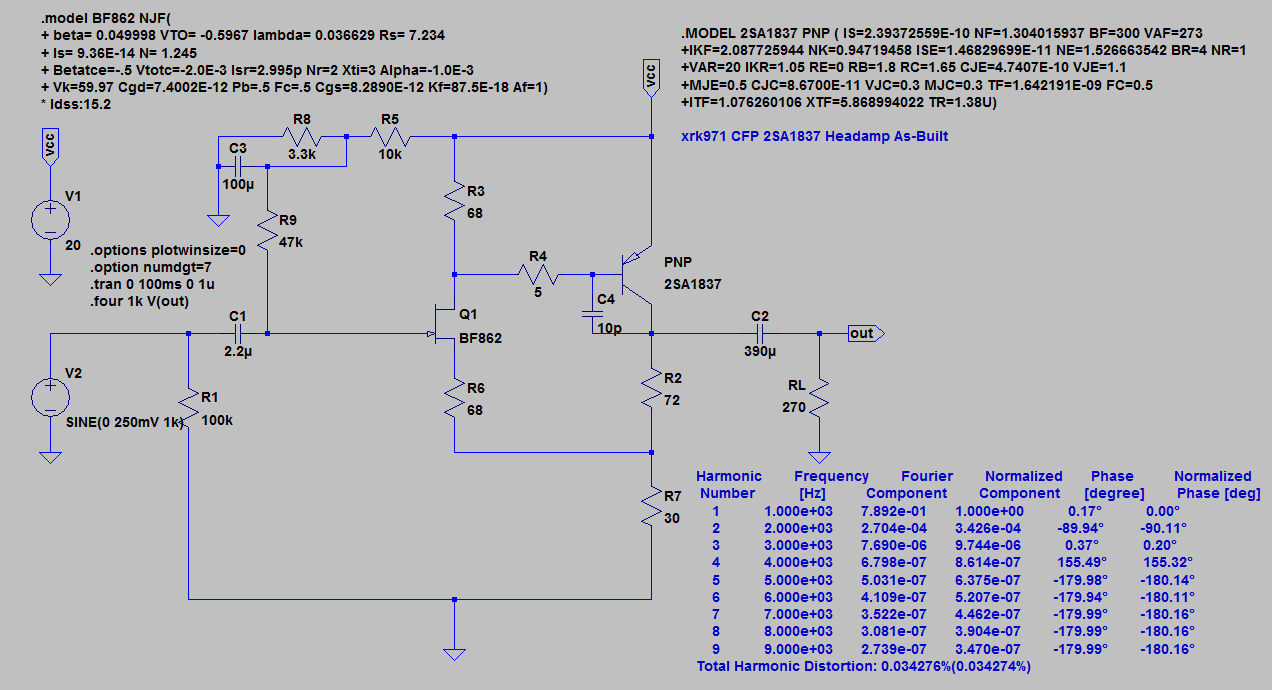
Last edited:
thank you XRK,
I guess Rl Is only for simulation and not needed
do you recommend specific headphone Impedance which Is best to use with your amp
would you consider design a simple dac to pair with HA
I guess Rl Is only for simulation and not needed
do you recommend specific headphone Impedance which Is best to use with your amp
would you consider design a simple dac to pair with HA
The above amp works from 300ohms to 60ohms. It will still drive a 30ohm headphone though just slightly reduced bass extension. If you want to use 30ohm
low impedance headphones just increase the output cap to 1000uF and it should work fine. You could also adjust it for higher bias current. I have t tried it but even 600ohm headphones should work as there is plenty of voltage.
low impedance headphones just increase the output cap to 1000uF and it should work fine. You could also adjust it for higher bias current. I have t tried it but even 600ohm headphones should work as there is plenty of voltage.
I don't know how to design DACs. But I use this one and you could easily stick it inside your box. It's got very high speed interface from XMOS U8. Sound very nice.
New version Assembled XMOS U8 + PCM5102 + TDA1308 USB Coaxial DAC Sound Card 32bit 384K headphone Output ,Free Shipping-in Amplifier from Consumer Electronics on Aliexpress.com | Alibaba Group
New version Assembled XMOS U8 + PCM5102 + TDA1308 USB Coaxial DAC Sound Card 32bit 384K headphone Output ,Free Shipping-in Amplifier from Consumer Electronics on Aliexpress.com | Alibaba Group
Maybe Aksa would be best to answer that. But short answe is you can't just change it. It's a zero global negative feedback amp so gain is closely tied to the design which is a fine balance of the resisors that set the bias on the master and slave transisotrs. I seem to recall gain is of order 3x. About right for a headphone amp.
New Desktop Amp based on Pocket Headamp
Here is something that BDHM and I are considering making for a new desktop amp based on the topology of the pocket amp - but with just more power. Now running about 150mA bias and having a 20v supply with dual matched MOSFETs, it can really drive lower impedance cans with more authority. Still very simple to make and hopefully we can get a new GB coming out for this in the near future.
Schematic & THD analysis:
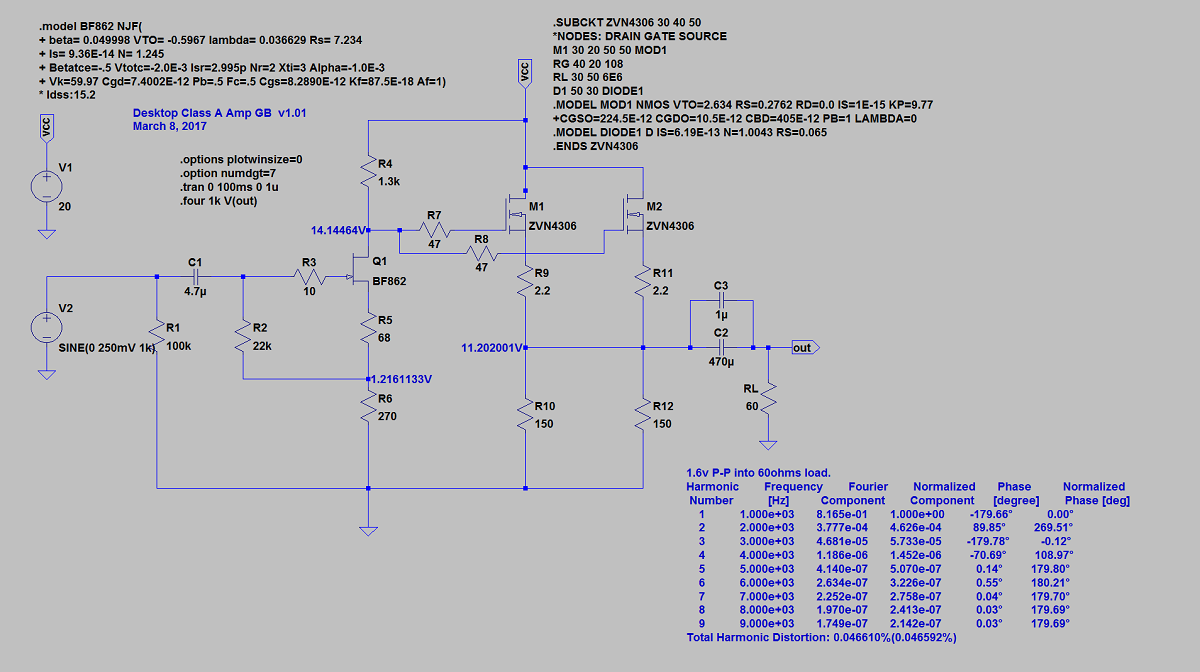
FFT for 60ohm load driven with 1.6v p-p:
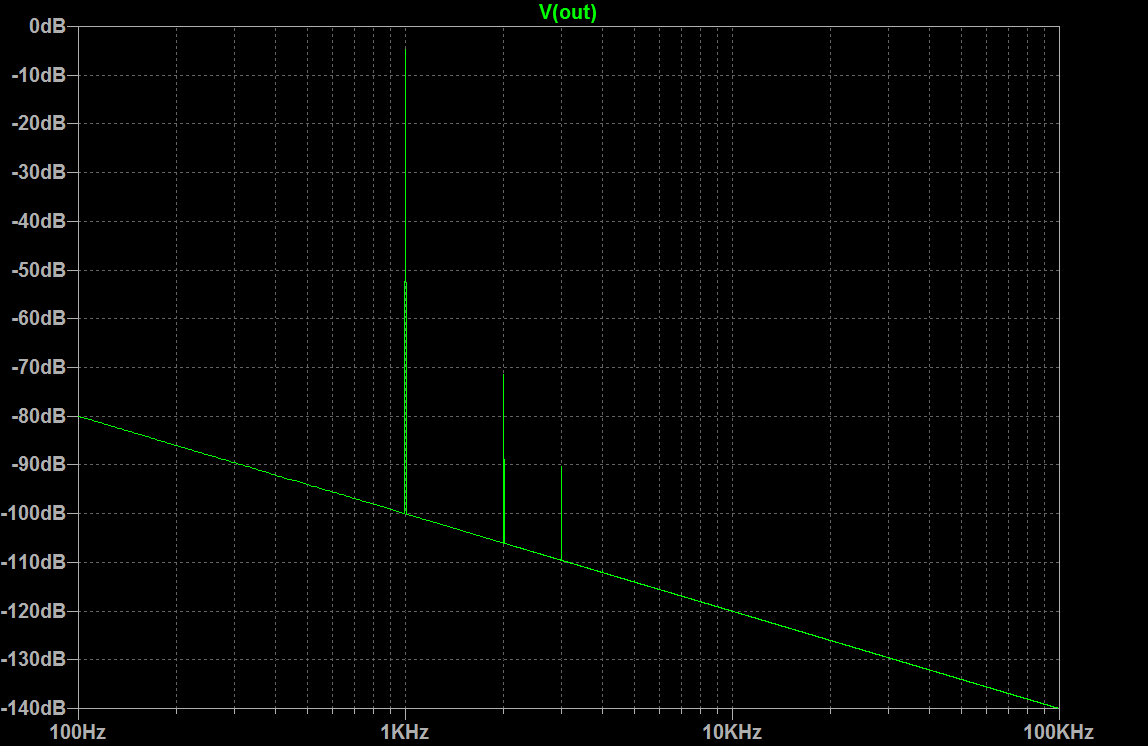
Output waveform for 250mV (500mV P-P) input:
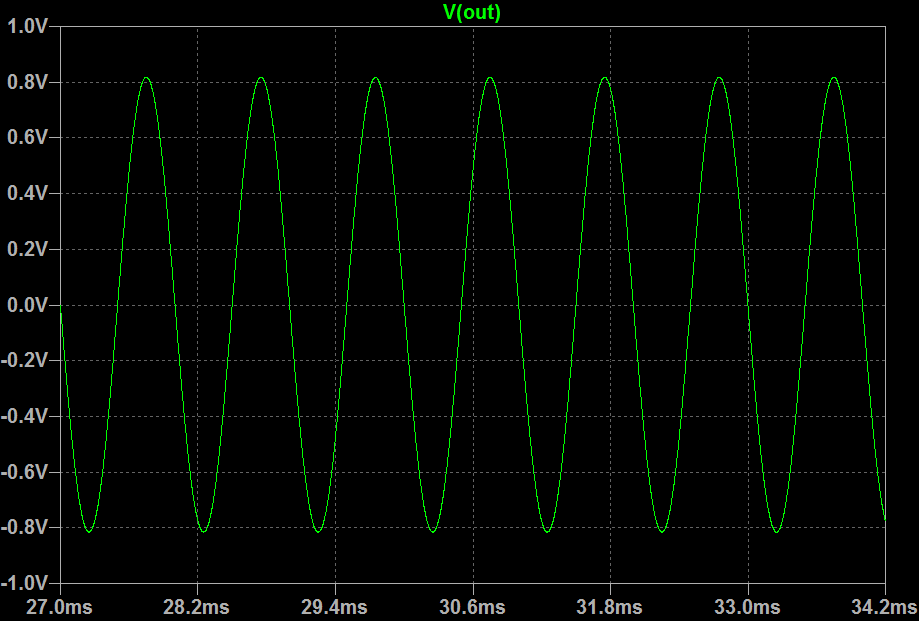
Of course, careful matching of output MOSFETs is needed to maximize performance but we know how to do that very well using self-circuit for in-situ FET matching.
Here is something that BDHM and I are considering making for a new desktop amp based on the topology of the pocket amp - but with just more power. Now running about 150mA bias and having a 20v supply with dual matched MOSFETs, it can really drive lower impedance cans with more authority. Still very simple to make and hopefully we can get a new GB coming out for this in the near future.
Schematic & THD analysis:

FFT for 60ohm load driven with 1.6v p-p:

Output waveform for 250mV (500mV P-P) input:

Of course, careful matching of output MOSFETs is needed to maximize performance but we know how to do that very well using self-circuit for in-situ FET matching.
Attachments
Last edited:
Yes, I am too. One thing to consider is how to implement an ultra-low ripple PSU. I have tested recently a way to get a few hundred mA of very low ripple (noise free) single rail power for low cost using common (cheap) off the shelf circuits.
Rather than a traditional transformer where we work really hard to get 120vac signals down to micro volt ripple - it's easier to use low cost SMPS (like a 5v USB charger or 12v external HD / router wall wart) to get a voltage that is *lower* than what is required. Then use an out-of-audio band 1.2MHz dc step up converter followed by some rudimentary (non-heroic) CRC filtering to smash that 1.2MHz RF signal down. 1.2MHz is so much higher than 40kHz that very steep passive filtering can be achieved for peanuts. By non-heroic efforts, I mean no series regs, no shunts or even cap multipliers requiring large heat sinks.
Here is an example of the 1kHz FFT spectrum from such a 1.2MHz DC step up followed by a simple CRCRC filter. Non audio (not the 1KHz and harmonics) are basically non-existent.
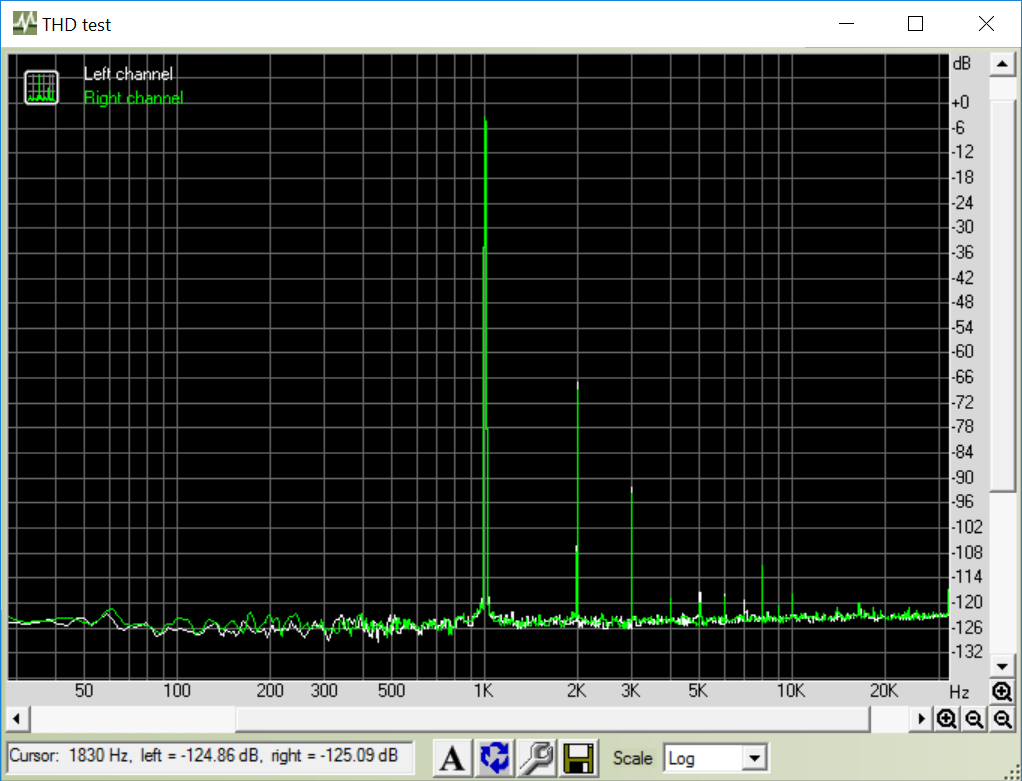
Rather than a traditional transformer where we work really hard to get 120vac signals down to micro volt ripple - it's easier to use low cost SMPS (like a 5v USB charger or 12v external HD / router wall wart) to get a voltage that is *lower* than what is required. Then use an out-of-audio band 1.2MHz dc step up converter followed by some rudimentary (non-heroic) CRC filtering to smash that 1.2MHz RF signal down. 1.2MHz is so much higher than 40kHz that very steep passive filtering can be achieved for peanuts. By non-heroic efforts, I mean no series regs, no shunts or even cap multipliers requiring large heat sinks.
Here is an example of the 1kHz FFT spectrum from such a 1.2MHz DC step up followed by a simple CRCRC filter. Non audio (not the 1KHz and harmonics) are basically non-existent.

Attachments
Last edited:
A simpler solution with single IRF610
I tried this out and now it's much simpler - no matching needed so resolution should be excellent. Able to drive 2v peak-peak into 60ohms cans witn 0.06% THD. THD can be made lower with R4 selection.
Schematic and THD analysis:
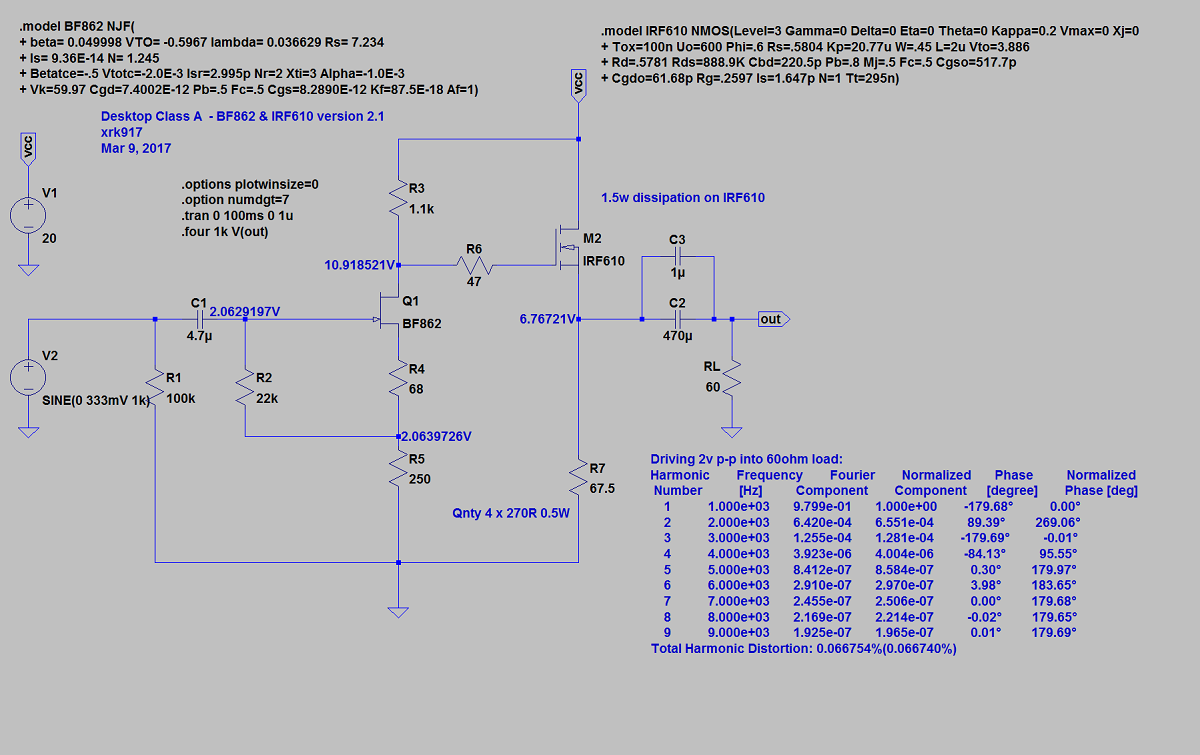
FFT for 2v P-P into 60ohms, gain is 3x:
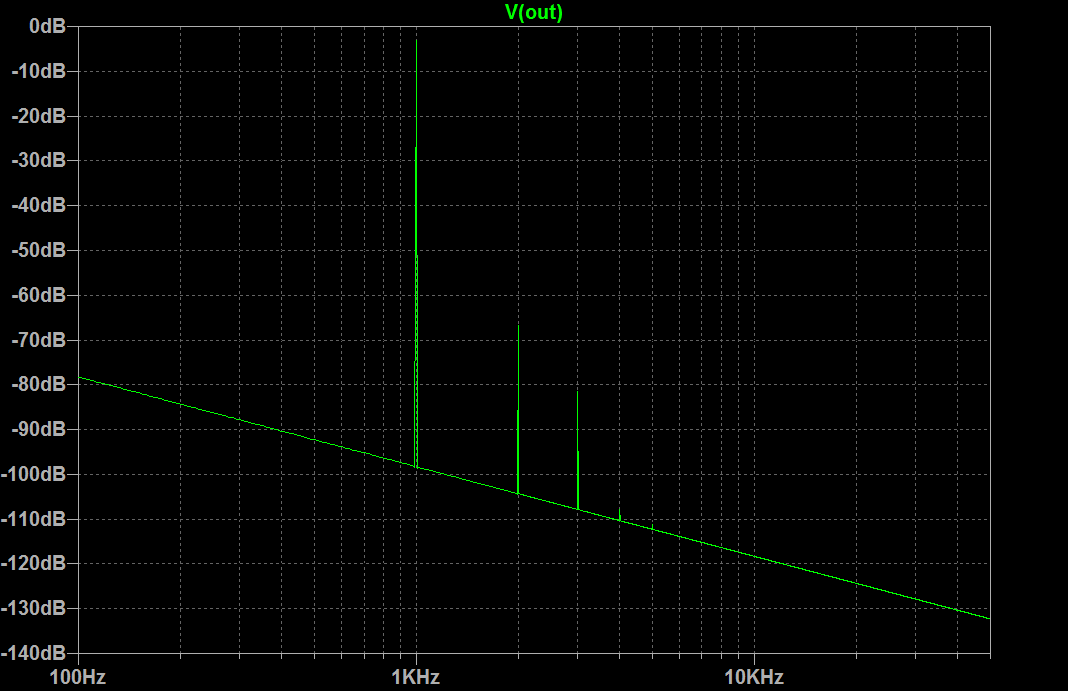
I tried this out and now it's much simpler - no matching needed so resolution should be excellent. Able to drive 2v peak-peak into 60ohms cans witn 0.06% THD. THD can be made lower with R4 selection.
Schematic and THD analysis:

FFT for 2v P-P into 60ohms, gain is 3x:

Attachments
Last edited:
By tried out, I meant in simulation. Luckily, it can be built quickly using the pocket amp PCB with an IRF610 standing up with heatsink and four through hole 270R 0.5w resistors.
Strange but I must have uploaded incorrect picture because DC setpoints are not correct. Here is correct one:
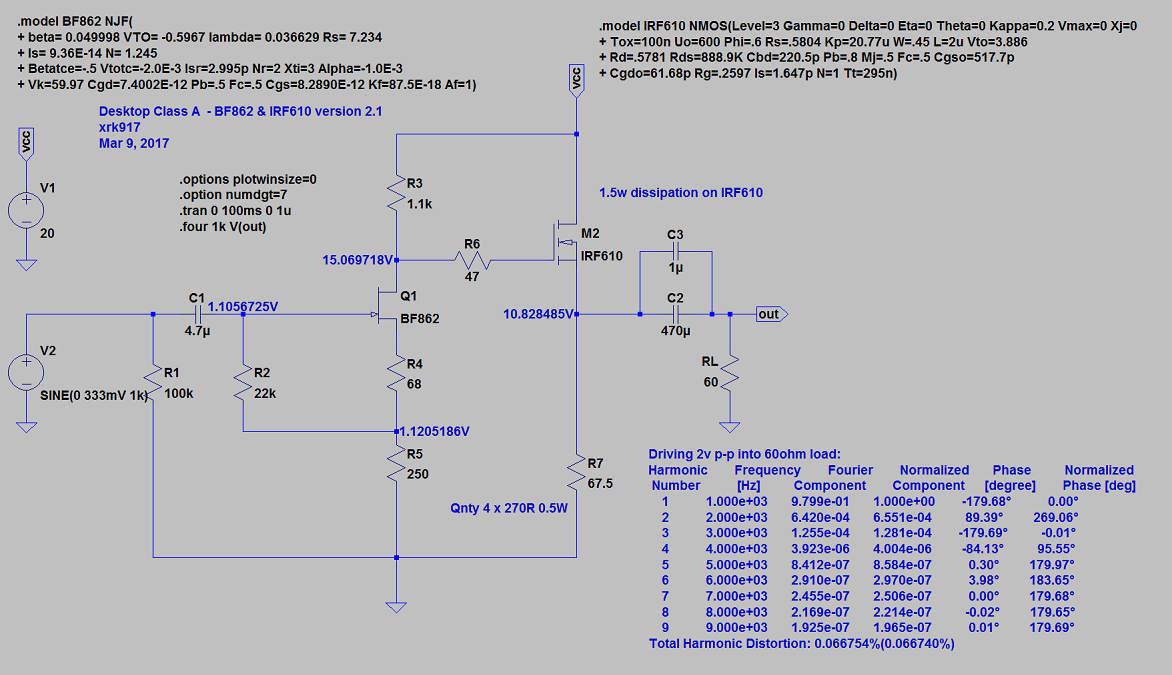
Voltage out of MOSFET Source should be circa 10v to 11v (around mid-point of supply voltage).
Strange but I must have uploaded incorrect picture because DC setpoints are not correct. Here is correct one:

Voltage out of MOSFET Source should be circa 10v to 11v (around mid-point of supply voltage).
Attachments
Last edited:
X, will a higher bias (~100-150mA) version offer any improvements for higher impedance headphones?
btw, I can't stop listening to the pocket version, I got a super short input cable so I can pair it with my phone more easily, but most of the time it's connected to my SMSL DAC from my mbp.
The sq improvement from the SMSL builtin headamp to your pocket amp is truly profound for me. It's 'accelerated' my plans to buy some 880's or even 990s, ha!
btw, I can't stop listening to the pocket version, I got a super short input cable so I can pair it with my phone more easily, but most of the time it's connected to my SMSL DAC from my mbp.
The sq improvement from the SMSL builtin headamp to your pocket amp is truly profound for me. It's 'accelerated' my plans to buy some 880's or even 990s, ha!
X, will a higher bias (~100-150mA) version offer any improvements for higher impedance headphones?
You might get improved transient dynamics - more "Slam" whatever that is 🙂 But most of the time, you may not notice the difference for 250ohm headphones. For 60 ohm or 30ohm cans, probably a bigger difference.
😀btw, I can't stop listening to the pocket version, I got a super short input cable so I can pair it with my phone more easily, but most of the time it's connected to my SMSL DAC from my mbp.
That's so good to hear how well it is working out. It's a surprisingly powerful little amp.

The DT880-250's was really a watershed event in my audio listening. The analogy is like hearing a time-aligned synergy horn for the first time with speakers.
Pcgab, I think you also built the 10 x BF862 SRPP amp - how does the pocket amp compare to that?
I just ordered some IRF610 in SMT D2PAK's - trick is how do we dissipate 1.5w from the PCB copper plane?
And 1.1k 0805 1% SMT resistors.
Also got some 4.7uF 50v film caps with 5mm pitch box style (Vishay). Ready to try this new desktop amp.
And 1.1k 0805 1% SMT resistors.
Also got some 4.7uF 50v film caps with 5mm pitch box style (Vishay). Ready to try this new desktop amp.
Pcgab, I think you also built the 10 x BF862 SRPP amp - how does the pocket amp compare to that?
I haven't finished it, now that I've measured 100 or so BF862's I have plenty to choose from for grouping. I'll probably do that this weekend sometime.
I just ordered some IRF610 in SMT D2PAK's - trick is how do we dissipate 1.5w from the PCB copper plane?
And 1.1k 0805 1% SMT resistors.
Also got some 4.7uF 50v film caps with 5mm pitch box style (Vishay). Ready to try this new desktop amp.
Funny I was just looking at the smt version of the 610's.
Maybe heatsinks like these would be adequate?
http://www.mouser.com/ProductDetail...=sGAEpiMZZMttgyDkZ5WiurC9qN77dzSrEtaEmPA/IeI=
or
http://www.mouser.com/ProductDetail...=sGAEpiMZZMttgyDkZ5WiuvXXea5LFo8pWFajzcE1YDs=
Hmm... I did not realize it but D2PAK looks just like a TO220 with tab snipped short and pins bent to lie flush with back? How does one mount this heatsink?
Hmm... I did not realize it but D2PAK looks just like a TO220 with tab snipped short and pins bent to lie flush with back? How does one mount this heatsink?
Looks like it has pegs to be soldered into the pcb:
http://www.mouser.com/ds/2/303/sink_d-181204.pdf
Great X!! Very good results; particularly high ratio of H2 to H5.
Looking over your results, it might be possible to supply lower voltage whilst maintaining the output range to up to 2Vpp. The higher 20V supply militates against economical battery supply; if it could be done at 12V, it would save dissipation as well. The big issue would be the BF862; taking it down will reduce it's linearity but it could be OK.
Cheers,
Hugh
Looking over your results, it might be possible to supply lower voltage whilst maintaining the output range to up to 2Vpp. The higher 20V supply militates against economical battery supply; if it could be done at 12V, it would save dissipation as well. The big issue would be the BF862; taking it down will reduce it's linearity but it could be OK.
Cheers,
Hugh
- Home
- Amplifiers
- Headphone Systems
- BF862 based SE Class A Headamp without the HEAT

